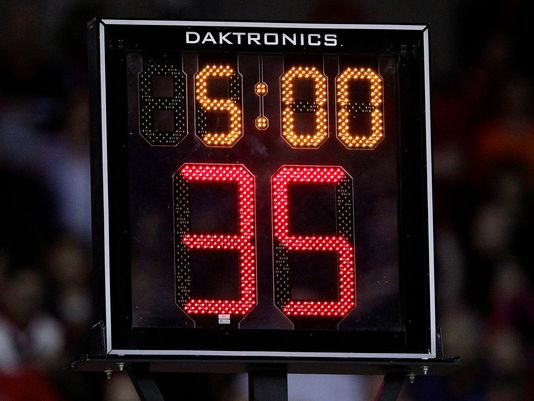On Friday, the story hit: The postseason NIT will experiment with a 30-second shot clock, down from the current 35-second clock. It’s also true that the restricted area underneath the basket (governing block-charge calls) will be expanded from three to four feet, but the shot clock is rightly seen as the much bigger story.
How should this experiment be received?
It’s easy to be angry. I will personally admit to being angry about this, simply because this is a wasted opportunity to experiment in a far more meaningful way. However, one’s immediate instincts and reactions can often be extreme or overly volatile, and I’ll plead guilty in this case.
I’ll soften my stance… but then explain why this is indeed a wasted opportunity.
*
Let’s give the powers that be in college basketball some credit: They didn’t have to experiment at all, but they’re trying to gather information and see what live-game action would look like under adjusted conditions. This is why it’s neither wise nor fair to react with anger in response to this move.
Players, coaches, officials — they’ll all get to see how the game flows and feels, and they’ll be able to do so for a few weeks, not just a single game on a single night. It makes sense to carry this experiment through a tournament, and it also makes sense on a certain level to not bust out this maneuver in the highest of high-stakes games: in the NCAA tournament. NIT games are widely televised by ESPN, the central live-game broadcaster in college sports, so a core television partner will give this experiment the visibility it deserves. That’s a good thing, too.
Anger’s not really a productive emotion here. Mea maxima culpa.
Now, with that having been acknkowledged, can it then be said that college basketball is failing to do as much as it can, to learn as much as possible about how its product can be improved and streamlined?
*
If we’re going to shave five seconds off the shot clock and expand the restricted area, why not cut down on timeouts? ESPN, as a television partner, would certainly have an interest in seeing how the lengths of games are (or aren’t) affected by a timeout change. The two-hour game window issue is a central one in college basketball television. ESPN could gather data on window lengths with a timeout change; the unwillingness of the sport to do so in this NIT experiment represents a missed chance.
Other areas for experimentation that are being ignored — thereby reducing the ability to gather equally important data points on a wider set of subjects — are as follows:
* Modified foul rules, in any of several directions: no foul-outs, six fouls for a foul-out, or more severe penalties for purposeful (non-flagrant) endgame fouls, just to name a few
* The modification of a 10-second violation such that a timeout called in backcourt doesn’t reset the 10 count (it currently does)
* Introducing multiple FIBA rules mentioned by TSS basketball writer Steve Fetch in this piece on Eight Ways To Fix College Basketball, chiefly the live-ball timeout prohibition and the allowance of touching the ball within the cylinder
The sport could do so much more in the way of experimentation, but it has chosen not to do so. If college basketball wants to change its product for the better, let’s see a complete revision, not just a tiny bit of tinkering at the edges. Moreover, none of this even touches on how much contact is or isn’t called, but that’s more about officials applying principles.
The shot clock, different foul limits, modifying the 10-second rule, changing timeout rules, and allowing touching in the cylinder — these are all very precise changes. What is and isn’t a foul is going to remain a point of debate as long as basketball is played.
So, no one needs to be angry that the NIT’s experiment is a limited one. At least the sport is trying to move forward and learn new things.
Now, let’s hope the sport is willing to learn more in the coming season. A fuller experiment in the early-season Thanksgiving tournaments of 2015 would be the natural time to see how additional rule modifications could help this sport to grow.
